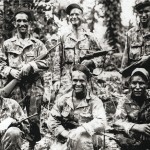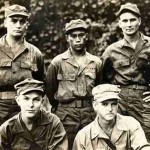 The Alamo Scouts were organized on Fergusson Island, New Guinea, on 28 November 1943 to conduct reconnaissance and raider work in the Southwest Pacific Theater under the personal command of then Lt. General Walter Krueger, Commanding General, Sixth U.S. Army.
The Alamo Scouts were organized on Fergusson Island, New Guinea, on 28 November 1943 to conduct reconnaissance and raider work in the Southwest Pacific Theater under the personal command of then Lt. General Walter Krueger, Commanding General, Sixth U.S. Army.
Named for his beloved association with San Antonio, Texas, and the Alamo, Krueger envisioned that the Alamo Scouts, consisting of small teams of highly trained volunteers, would operate deep behind enemy lines to provide intelligence-gathering and tactical reconnaissance in advance of Sixth U.S. Army landing operations.
During these two years the Alamo Scouts liberated 197 Allied prisoners in New Guinea, and provided forward reconnaissance and tactical support of the Sixth Ranger Battalion in the liberation of the Cabanatuan Prisoner of War Camp on Luzon, in February 1945, freeing 511 Allied prisoners. In addition, the Alamo Scouts captured 84 Japanese prisoners of war.
The Alamo Scouts evolved from a simple reconnaissance unit in New Guinea to a sophisticated intelligence collection group which supplied and coordinated large-scale guerrilla operations on Leyte and Luzon.
In July 1945, the Alamo Scouts were training to conduct pre-invasion reconnaissance of Kyushu in preparation for OPERATION OLYMPIC, the first step in the proposed Allied invasion of the Japanese homeland. Following the Japanese surrender, the Alamo Scouts landed in Wakayama and became part of the occupation army
They were unceremoniously disbanded at Kyoto, Japan, in November 1945, never to be reconstituted.
The Alamo Scouts have the finest record of any elite unit of World War II and, arguably, one of the finest in the history of the United States military.
In 1988, the Alamo Scouts were individually awarded the SPECIAL FORCES SHOULDER TAB for their services in World War II and included in the lineage of today’s U.S. Army Special Forces.
Cabanatuan Raid Story: When General Krueger began planning the raid on Cabanatuan, he sent for the Alamo Scouts.
Two teams of Scouts were chosen to work the mission. The Nellist and Roundsville teams undertook reconnaissance of Cabanatuan. They gathered useful information on Japanese movements in the camp’s vicinity. In fact, they confirmed USAFFE guerrilla leader Juan Pajota’s intelligence — Japanese activity in the area was tremendous. They concurred that the raid should be postponed for 24 hours.
Nevertheless, they were stymied. They needed better information on the movements within the camp and they couldn’t get near the camp — the surrounding fields were too flat. They were sure to be seen. Time was ticking past; the Scouts were getting frustrated. They needed more information. What could they do?
Lieutenant Bill Nellist hatched a plan. He reasoned that although it was impossible to get near the camp, they could spy on the camp from a higher outpost. He had spotted an abandoned shack that just might be able to provide the vantage. It was risky, but he decided that he and Rufo Vaquilar, a Filipino-American Alamo Scout, would dress up as Filipino villagers and attempt to gain access to the hut.
The plan worked. Nellist and Vaquilar donned straw hats and farmer costumes; they sallied for the shack. Nellist couldn’t have been more pleased. The view was extraordinary; they could see right into the compound. For two hours they made notes, detailing the major features of the camp and the best routes for the Rangers. Then they heard a strange noise — three more Alamo Scouts had come to join them. These daring young men had crawled on their bellies, approaching the shack from the rear. Nellist gave them his report and ordered them to get it to Ranger commander Henry Mucci, on the double.
The information was a godsend. The Rangers completed their plan. That evening the raid began. The Scouts helped evacuate the prisoners. Then they stayed behind, helping with casualties and surveying the area for any retaliatory movements. By February 2, they made their way back to base camp. According to the diary of Alamo Scout Gilbert Cox, they finally found themselves “enjoying life and waiting for the next job.”
Want to read another great Alamo Scout story? Try this link.
Posted for Veteran’s Day – Monday Nov. 11th 2013



